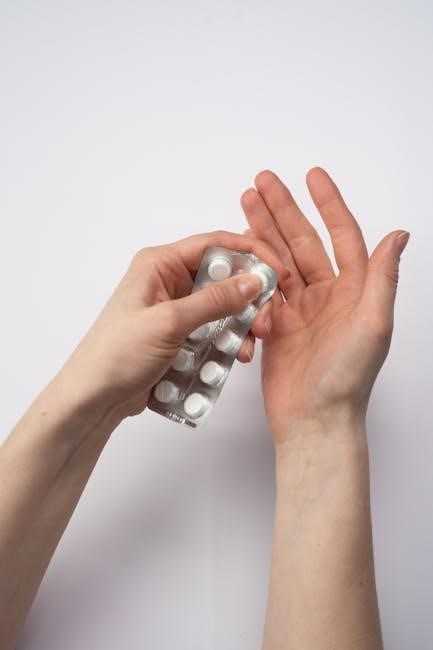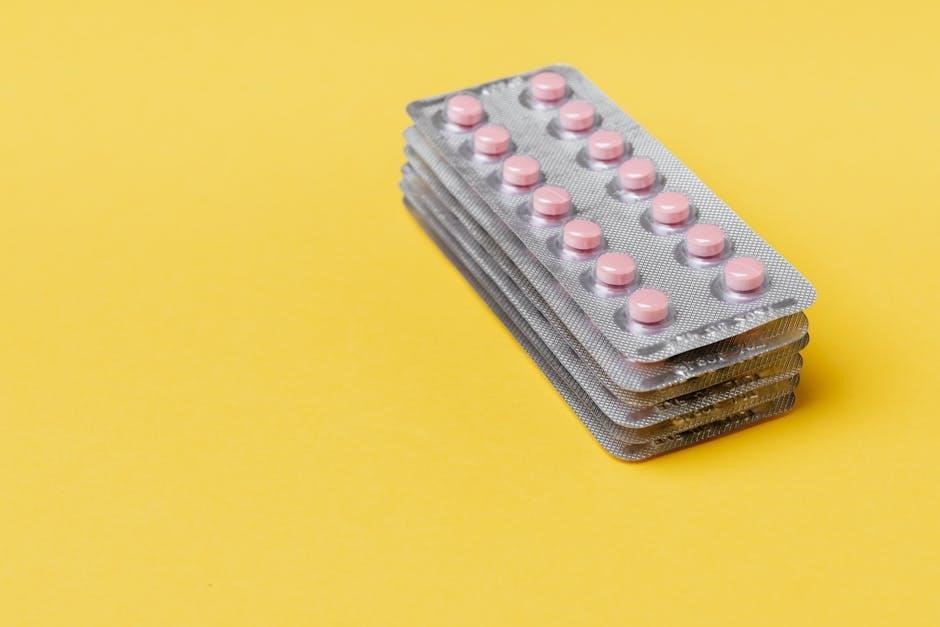
The ACLS Drugs Cheat Sheet is a vital resource for healthcare professionals, offering essential medication details during emergencies. It clearly outlines key drugs, dosages, and usage guidelines, ensuring a standardized approach in critical situations.
1.1 Overview of ACLS and Its Importance
Advanced Cardiovascular Life Support (ACLS) is a critical set of protocols for managing life-threatening cardiac events, such as cardiac arrest and arrhythmias. It emphasizes standardized approaches to maximize patient outcomes. The ACLS Drugs Cheat Sheet is an indispensable tool, providing quick access to essential medication information, including dosages, administration routes, and indications, ensuring healthcare providers can act swiftly and accurately during emergencies. It supports timely interventions, improving survival rates and effective care delivery.
1.2 Purpose of the ACLS Drugs Cheat Sheet
The ACLS Drugs Cheat Sheet serves as a concise, quick-reference guide for healthcare providers during emergencies. It simplifies complex medication information, ensuring accurate and timely administration. By organizing drug dosages, routes, and indications, it minimizes errors and enhances decision-making. The cheat sheet also promotes adherence to evidence-based protocols, helping providers deliver optimal care during high-stakes situations like cardiac arrest and arrhythmias.

Key Drugs Used in ACLS
Essential ACLS drugs include Epinephrine, Vasopressin, Adenosine, Amiodarone, Lidocaine, and Magnesium. These medications target cardiac arrest, arrhythmias, and hemodynamic instability, serving as vasopressors or rhythm controllers.
2.1 Epinephrine
Epinephrine is a critical ACLS drug, primarily used in cardiac arrest for VF/Pulseless VT. The standard dose is 1 mg IV every 3-5 minutes, or 2.0-3.0 mg via E-T Tube in 10cc NS. It functions as a vasopressor, increasing heart rate, contractility, and peripheral vascular resistance, aiding in restoring circulation during emergencies. Its administration during CPR ensures medication circulation, making it indispensable in resuscitation efforts.
2.2 Vasopressin
Vasopressin is a vasoactive agent used in ACLS, particularly for cardiac arrest. It can substitute one dose of epinephrine at 40 units IV/IO. It increases vascular resistance and blood pressure, aiding in perfusion during CPR. Primarily indicated for VF/Pulseless VT, vasopressin supports circulatory efforts when epinephrine is ineffective. Proper administration and flushing techniques are crucial for its effectiveness in critical scenarios.
2.3 Adenosine
Adenosine is primarily used in ACLS for treating supraventricular tachycardia (SVT) and certain ventricular arrhythmias. It works by transiently blocking AV node conduction, restoring sinus rhythm. The standard dose is 6mg IV/IO, repeated as needed. It’s contraindicated in asthma, bradycardia, and heart blocks without a pacemaker. Side effects are short-lived, making it a preferred option for rapid arrhythmia control.
2.4 Amiodarone
Amiodarone is a key antiarrhythmic drug in ACLS, primarily used for wide QRS tachycardia and ventricular fibrillation/pulseless VT unresponsive to shocks. The loading dose is 150mg IV, with a repeat dose of 150-300mg if needed. It acts as a vasodilator and can cause hypotension. Proarrhythmic effects are rare but possible. Its long half-life ensures prolonged effects, making it a preferred choice for arrhythmia management in critical situations.
2.5 Lidocaine
Lidocaine is an antiarrhythmic drug used in ACLS for ventricular tachycardia unresponsive to defibrillation or epinephrine. The initial dose is 1mg/kg IV, followed by 0.5mg/kg every 5-10 minutes, with a maximum of 4mg/kg. It works by blocking sodium channels, stabilizing the heart rhythm without significantly depressing myocardial contractility. Lidocaine is particularly effective in ischemia-related arrhythmias and is often administered when other agents fail.
2.6 Magnesium
Magnesium is used in ACLS for torsades de pointes and ventricular fibrillation/pulseless VT unresponsive to defibrillation. The dose is 1g IV, which can be repeated once. It helps reduce arrhythmia recurrence and is particularly effective in magnesium-deficient patients. Magnesium does not depress myocardial function, making it a safer option in specific scenarios compared to other antiarrhythmic agents.

Drug Administration Tips
Administer ACLS drugs during CPR to ensure proper circulation. Use IV or intraosseous access for rapid effect. Flush with saline to maintain drug efficacy and prevent complications.
3.1 IV vs. Intraosseous (IO) Access
IV access is preferred for rapid drug administration during ACLS. If IV is unavailable, intraosseous (IO) access is a reliable alternative, ensuring timely drug delivery. Both routes require proper flushing to maintain efficacy and prevent complications, ensuring optimal circulation of medications during critical situations.
3.2 Flush and Elevated Extremity Technique
After administering drugs via IV or IO, flush with 20 mL of saline to ensure full delivery; Elevate the extremity above heart level for 10-20 seconds to prevent pooling. This technique enhances drug circulation, especially in cardiac arrest scenarios, ensuring optimal absorption and effectiveness of medications during critical resuscitation efforts.

Common Indications for ACLS Drugs
ACLS drugs are primarily used in cardiac arrest, tachycardia (SVT, VT), and bradycardia to restore normal heart rhythms and improve survival rates during critical emergencies.
4.1 Cardiac Arrest (VF/Pulseless VT)
VF (ventricular fibrillation) and pulseless VT are life-threatening arrhythmias requiring immediate intervention. ACLS drugs like epinephrine (1 mg IV/IO q3-5 min) and vasopressin (40 units IV/IO) are administered to restore perfusion and rhythm. These drugs increase coronary and cerebral blood flow, enhancing the likelihood of successful defibrillation. Administration during CPR ensures medication circulation, improving survival outcomes in cardiac arrest scenarios.
4.2 Tachycardia (SVT, VT)
Adenosine is the first-line treatment for supraventricular tachycardia (SVT), administered as a rapid IV bolus (6-12 mg). It temporarily blocks AV nodal conduction, terminating the arrhythmia. For ventricular tachycardia (VT), especially wide-complex tachycardia, amiodarone is preferred (150-300 mg IV). Early intervention is critical, with rhythm assessment and synchronized cardioversion if unstable. These drugs help restore sinus rhythm, improving cardiac stability and patient outcomes.
4.3 Bradycardia
Bradycardia treatment focuses on increasing heart rate to restore adequate perfusion. Atropine is the first-line agent (0.5 mg IV every 3-5 minutes, up to 3 mg total), blocking vagal tone to enhance sinoatrial node activity. If ineffective, transcutaneous pacing is recommended. For symptomatic bradycardia unresponsive to pacing, dopamine or epinephrine infusions may be initiated. Close monitoring and adjustment of therapy are critical to achieve and maintain a stable cardiac rhythm.
ACLS Drug Dosing Guide
The ACLS Drug Dosing Guide provides standardized medication dosages and administration routes, ensuring adherence to AHA guidelines. Adjustments for special populations and weight-based dosing are emphasized, optimizing efficacy and safety during emergencies. Proper administration techniques, such as IV flushing and extremity elevation, are highlighted to enhance drug circulation and effectiveness in critical situations.
5.1 Standard Doses for Adults
Standard ACLS doses for adults include Epinephrine 1 mg IV/IO every 3-5 minutes, Vasopressin 40 units IV/IO as an alternative, Adenosine 6-12 mg IV for SVT, Amiodarone 300 mg IV/IO for VF/VT, Lidocaine 1 mg/kg IV/IO, and Magnesium 1-2 grams IV/IO for torsades de pointes. Always flush with 20 mL saline and elevate the extremity after IV administration. Adhere to AHA guidelines for optimal efficacy and safety.
5.2 Adjustments for Special Populations
For pediatric patients, doses are weight-based. Geriatric or renally impaired patients may require reduced doses. In hepatic impairment, drugs like Amiodarone may need adjustment. Pregnant women generally follow standard dosing but with cautious monitoring. Always consider individual patient factors and consult specific guidelines for precise adjustments. Tailoring doses ensures efficacy and minimizes risks in vulnerable populations during ACLS.

Common Mistakes to Avoid
Common mistakes include dosage errors, improper administration techniques, and failure to consider drug interactions. Ensure medications are given during CPR, not during pauses, to maintain circulation. Avoid contraindications and monitor side effects closely.
6.1 Dosage Errors
Dosage errors are critical in ACLS, as incorrect dosing can worsen patient outcomes. Ensure accurate administration of drugs like epinephrine (1 mg IV/IO) and vasopressin (40 units). Adenosine for SVT is 6 mg IV, repeated if needed. Always double-check dosages and intervals, and use standardized guidelines to prevent miscalculations. Proper flushing and elevation techniques are essential to ensure drug efficacy. Never exceed recommended doses, as this can lead to adverse effects or complications.
6.2 Contraindications and Side Effects
Understanding contraindications and side effects of ACLS drugs is crucial. Epinephrine may cause hypertension or tachycardia, while vasopressin is contraindicated in cardiac arrest due to its vasoconstrictive effects. Adenosine should be avoided in asthma or heart block. Lidocaine can cause neurological side effects, and magnesium may lead to respiratory depression. Verapamil is contraindicated in severe heart failure. Always review patient history and current conditions before administration to minimize risks and ensure safe use of these medications.
The ACLS Drugs Cheat Sheet serves as a quick reference guide, ensuring healthcare professionals administer medications safely and effectively during emergencies. Familiarize yourself with these drugs, their doses, and proper administration techniques to enhance patient outcomes and stay updated with the latest ACLS guidelines.
7.1 Final Tips for Effective Drug Administration
- Administer drugs during CPR to ensure circulation and maximize effectiveness.
- Use IV or IO access for rapid drug delivery, flushing with 20 ml saline post-administration.
- Elevate the extremity above heart level for 10-20 seconds to enhance absorption.
- Monitor for contraindications and side effects, adjusting doses as needed.
- Stay updated with ACLS guidelines to ensure evidence-based practice.
7.2 Importance of Practice and Updates
Regular practice and staying updated on ACLS guidelines are crucial for effective drug administration. Familiarity with the latest recommendations ensures adherence to evidence-based practices. Continuous education helps healthcare providers master drug dosages, contraindications, and administration techniques. Updated protocols may include new drugs or revised doses, requiring ongoing learning to deliver optimal care during emergencies.
- Practice ACLS scenarios to reinforce drug administration skills.
- Review AHA guidelines regularly for updates.
- Engage in simulations to improve response times and accuracy.